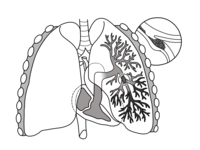
Photo from wikipedia
Objective: The emergence of novel oral anticoagulant agents (NOACs) has increased the ability of physicians to provide patients with reliable anticoagulation (AC) therapy for venous thromboembolism (VTE). Their effectiveness in… Click to show full abstract
Objective: The emergence of novel oral anticoagulant agents (NOACs) has increased the ability of physicians to provide patients with reliable anticoagulation (AC) therapy for venous thromboembolism (VTE). Their effectiveness in comparison to vitamin K antagonists as well as their relative safety profile is well documented in the literature. The treatment of VTE continues to evolve, and data suggest a therapeutic advantage of pharmacomechanical thrombolysis combined with AC over AC alone in the treatment of select patients with VTE. However, the relative lack of knowledge regarding NOACs among physicians coupled with the lack of approved reversal agents limits their widespread use. Vitamin K antagonists remain the mainstay of long-term outpatient oral AC therapy. Even with the present data, the safety of NOACs after advanced therapies with tissue plasminogen activator (tPA) remains unclear. We set out to study the safety of NOACs, specifically Xa inhibitors, immediately after thrombolysis therapy with tPA in patients with VTE. Methods: A retrospective review of patients’ records at a single institution was conducted. Our study included patients who underwent catheter-directed thrombolysis (CDT) with tPA for VTE, with subsequent early initiation of an NOAC, from January 2015 to September 2017. Data were collected on demographics, characteristics of VTE, treatment modality, and outcomes. All patients had a minimum follow-up of 3 months. End points were bleeding complications as defined by Global Utilization of Streptokinase and Tissue Plasminogen Activator for Occluded Coronary Arteries (GUSTO) criteria and recurrence of VTE. Results: A total of 42 patients (52% female; mean age, 55 years) underwent CDT with an EkoSonic catheter (EKOS Corporation, Bothell, Wash) and tPA while AC was maintained with intravenous unfractionated heparin. Completion of CDT was followed by initiation of an NOAC; 80% of patients were treated with CDT for submassive pulmonary embolism (mean tPA dose, 24 mg) and the remainder for extensive deep venous thrombosis (mean tPA dose, 12 mg). All patients were transitioned to an oral direct Xa inhibitor on postprocedure day 1 (74% to apixaban vs 26% to rivaroxaban). No bleeding complications were recorded in any of the patients, independent of tPA dose, type of VTE treated, or therapeutic oral agent used. No VTE recurrences were encountered at 3-month follow-up. Conclusions: NOACs, specifically direct Xa inhibitors, appear to be a safe therapeutic option for patients with VTE undergoing CDT with tPA. In our study, neither bleeding complications nor recurrent VTEs were observed. Our study is limited by its retrospective nature and small sample size. Larger prospective studies are needed to confirm these results.
Journal Title: Journal of Vascular Surgery
Year Published: 2018
Link to full text (if available)
Share on Social Media: Sign Up to like & get
recommendations!